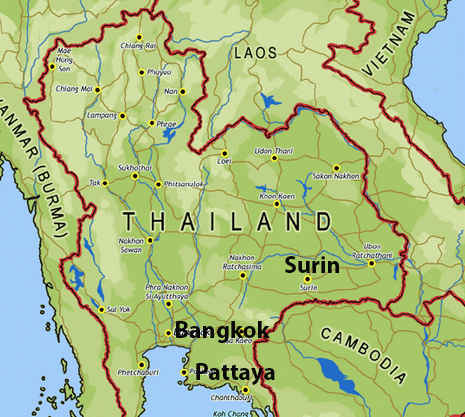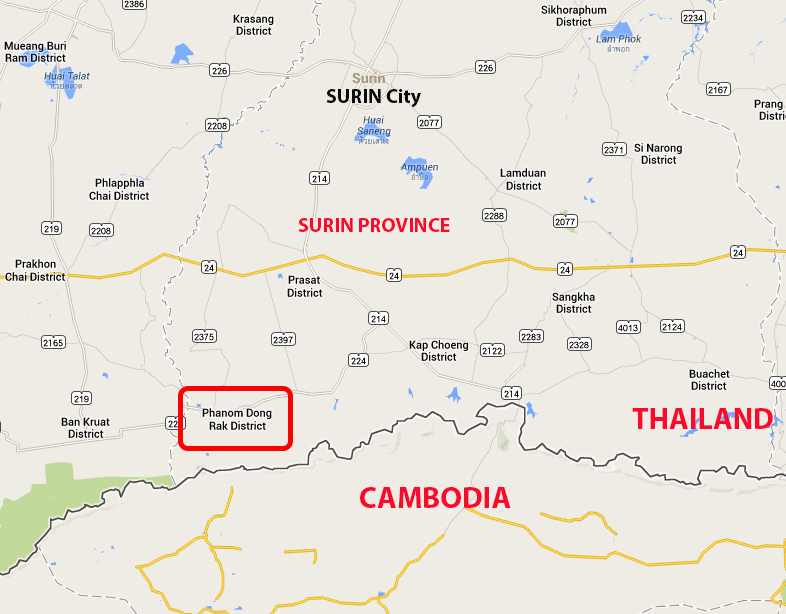DONG RAK VILLAGE, PHANOMDONGRAK DISTRICT:
SURIN PROVINCE
SURIN
is both a province of Thailand and its capital city. It lies in the southernmost part of the Isaan District of Thailand.
Isaan is the northeastern region of Thailand. It is located on the Khorat Plateau, bordered by the Mekong River (along the border with Laos) to the north and east, by Cambodia to the southeast and the Prachinburi mountains south of Nakhon Ratchasima. To the west it is separated from Northern and Central Thailand by the Phetchabun mountain range.
The main language is Isaan Lao, which is a dialect of the Lao language. Currently written with the Thai alphabet (instead of the slightly different Lao alphabet), Isaan Lao belongs to the Chiang Seng and Lao–Phutai language groups, which along with Thai are members of the Tai languages of the Tai–Kadai language family. Thai is also spoken by almost everyone and is the language used in education. Khmer, the language of Cambodia, is widely spoken in areas along the Cambodian border: Buriram, Surin, and Sisaket. The people are aware of their Lao ethnic origin, but Isaan has been incorporated into the modern Thai state.
About 450 kilometers from Bangkok and 50 kilometers from the Cambodian border, Surin is an ancient historical province from the Khmer period. This province is regarded as the land of elephants, with around 300-500 wild elephants.
The Surin Provincial Administrative Organization has carried out a project known as “Elephant World,” for elephant conservation. Listed as an endangered species, the Thai elephant is regarded as the national animal. Poaching of wild elephants is forbidden and captive or domestic elephants need to be registered and be given an identity certificate.
Surin is famous for organic Hom Mali rice, or Thai jasmine rice, as well. The brand of Hom Mali is well-known worldwide, especially in the high-end market. The province has also earned a reputation of its fine Thai silk and notable silver beads. The town of Surin is surrounded by villages that produce silk and a variety of handicrafts.
There are numerous ancient Khmer sanctuaries, which testify to the historical significance of this province. The population of Surin is 1.38 million, with about 342,000 households.
MONDAY 2nd (continued):
Jack’s first sight of his grandfather and two uncles was nice to see but we were all very weary after the long drive made worse by the previous night’s entertainment.
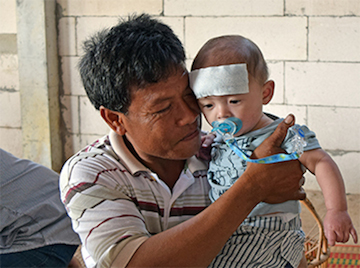
| 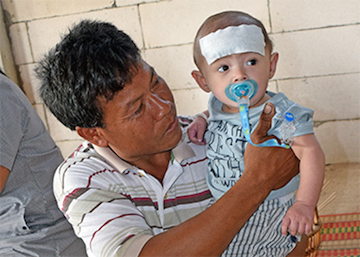 |
Aom's father, Chet's first contact with his new grandson. Jack had a mild condition and was not his normal little self. The white "bandage" on Jack's forehead is a medicinal patch to help control his raised temperature.
Jack’s first sight of his granddad and two uncles was nice to see but we were all very weary after the long drive made worse by the previous night’s entertainment.
Later in the evening Aom’s grandmother (Jack’s great-grandmother) popped round with a cousin or two to come see the new baby.
However, it had been clear for several hours that Jack was unwell and running a temperature. The 30ºc+ air temp didn’t help either. I put it down to the sudden change in climate from a cold English winter to the torrid humidity of Thailand. Bangkok’s polluted city air also must have had an effect. It was decided to pop Jack along to take Jack to see a doctor, the nearest one being 6 or 7 miles away.
Doctors and medical matters generally in Thailand are very good and on a par to UK… but you have to pay for it.
However, the doctor’s “surgery” couldn’t have been more different from the usual UK type. It was literally a tiny concrete block with a single short bench to wait on. The GP sat behind the desk in the same area as the waiting area; no privacy whatsoever which didn’t bother Jack of course.
He was seen to in a short time and, as I suspected, he had a slightly raised temperature; the discomfort made worse by change in environment. I can understand this as the change in climate affects me and it takes several days to acclimatise.
Some medicine to help drop his temp and advice on keeping the little chap hydrated was prescribed. All paid-up we were back home by 8pm.
TUESDAY 3rd:
It was the gathering of the Clans today. The whole huge family came along to the house and wanted to see the new baby and welcome Aom back (I got a welcome too).
At 3:30am Aom’s mum, Somjit, left for the nearest market town of Prasat, around 20 miles away, to buy fresh food. From early morning, in fact dawn, people started to appear and cooking and food preparation commenced.
Eventually, by mid morning the celebrations began with lots of prayers and Buddha offerings. Baby Jack, Aom and myself being the centre of the business. It was a madhouse with everyone talking at once. To a non-Thai it would appear chaotic but each person knows the drill. The eating takes an age with dozens of different dishes; pork, chicken, loads of fish and an abundance of strange-looking but very tasty vegetables. Not all Thai food is highly spiced. Most is fairly gentle aromatic spices and herbs. REAL Thai food at its best and somewhat different from the food offered in Thai restaurants in UK.
The main reason that these festivities start so early is because people have their own farms to care for and animals to tend.
In spite of this, the festivities carried on through to the afternoon with family members coming and going.
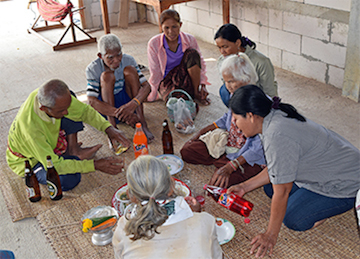
| 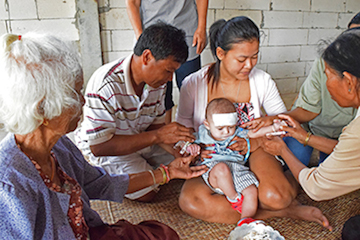 |
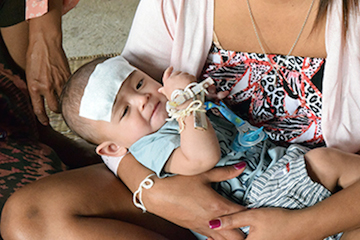
| 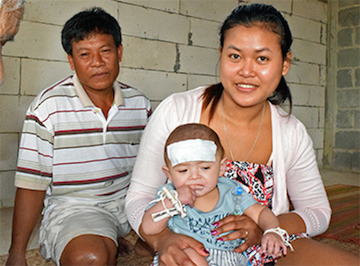 |
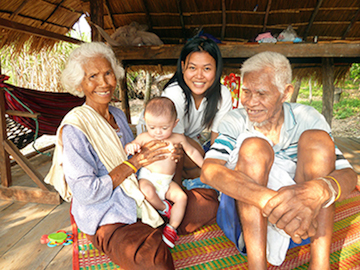
| 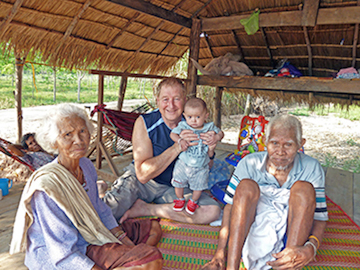 |
TOP LEFT: Gathering of the clans, e.g., the family members. All come visit to welcome us home and, in particular, the new baby. Various drinks are offered to Buddha and prayers chanted.
TOP RIGHT: Lengths of white thread are tied around the wrists of newcomers. This is a welcoming blessing into the family.
CENTRE LEFT: New members, i.e., Jack have bank notes tied within the thread as an additional blessing of future good fortune.
CENTRE RIGHT: Jack, Aom and the new grandfather, Chet, just after the Welcoming.
BOTTOM LEFT: Aom with her grandparents; Jacks great grandparents. They are both in their mid 90's.
BOTTOM RIGHT: Yours truly with the grandparents. Lovely people. The grandmother, in particular, is totally switched on and mentally shows no sign of her advanced years.
It takes several days to unwind and adapt to the pace of Thai village life. So enormously different from the hurly-burly of crazy Bangkok. It can be frustrating as here in the Thai back-of-beyond everything and everyone moves slowly. It takes Thais an age to do anything but after a while you find yourself unwinding and adapting. Village life is, I have to say, crude by home-in-England standards. Cooking facilities are basic and personal hygiene takes some adapting. This is not to say the Thai family is in any way unclean, quite the contrary, they are intensely clean and shower far more often than many farang (Thai for any westerner).
It was good to see that Aom’s father, Chet, had installed a Western-type lavatory basin and a proper shower. Previously, the lavatory basin was the squat-on style (still seen in parts of France and Spain unbelievably) and the shower was a case of ladling cold water over you.
Timing takes some getting used to as well. It gets dark at around 6:30 and the family eat at around 7pm. After banter about the day's goings-on it's generally bedtime around 9pm. It's up and about again at 04:30, just before dawn. Work starts around the farm then and breakfast is usually around 08:30-09:30. Takes a bit of getting used to but it makes for a nice long day by making full use of daylight hours.
WEDNESDAY 4th:
It started off a typical steaming hot morning but baby Jack had not had a good night. Aom, Jack and I had taken to sleeping in the gazebo-type outbuilding using the mattress and mosquito netting from the house. It’s much cooler out there and very restful. The occasional animal rustles, squeaks and grunts are not a problem.
With temperature just into the 40’s, it was because of baby Jack’s condition showing little sign of improvement we decided to take him to the private hospital in Surin city. One of Aom’s cousins arrived at 06:30 in his off-road Isuzu pickup to take us the 60km to Surin.
In due course Jack was seen by a paediatrician. Thankfully, his symptoms were not severe and advice on hydration and keeping cool was given. Some medicines to assist were prescribed. All this for 750Baht (around £15).
It was still only around 10:30am so we decided on a late breakfast at a coffee-shop in Surin.
One thing that has always irritated me a little in the past was to see Somjit slave away at hand-washing clothes in enormous bowls. Bloody hard work for her!
Anyway, on the way back on the outskirts of Surin we called into a big home store (very similar to B&Q in UK… but with assistants who were actually readily available). The time had come for me to splash out on a washing machine for Somjit. An 8kg Samsung model was chosen and that was the easy bit. There’s something about Thai checkouts that always appear to have problems with my credit cards. The first card was declined throwing the cashier into total confusion. It took a supervisor to sort it but only after I used a different card.
It turned out that the error was with the checkout terminal and not my first card. Amusingly, the washing machine and other bits I’d bought had already been loaded on the back of the pick-up so I could have just walked out of the store! No way could you be allowed to load before payment in UK.
One more stop at a roadside noodle type place and it was back to Dhong Rak.
More family members came round in dribs and drabs throughout the afternoon and into the evening. Jack was lot better now.
A few birthday drinks and a late meal were enjoyed; crawled under the mosquito netting at around midnight.
So that was my birthday! First one spent abroad. And what did I do? I bought my mother-in-law a new washing machine and took my baby son to hospital. Certainly very different.
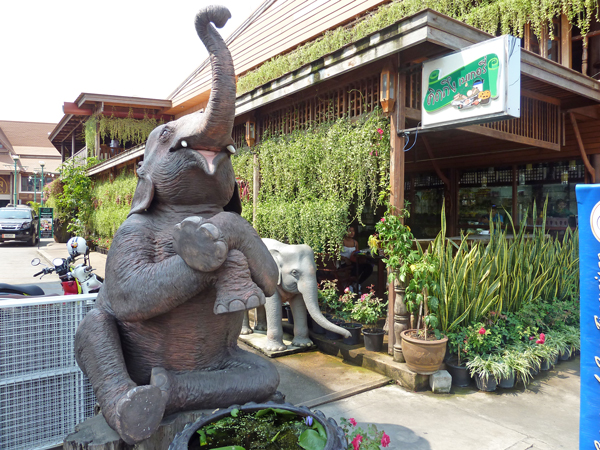
| 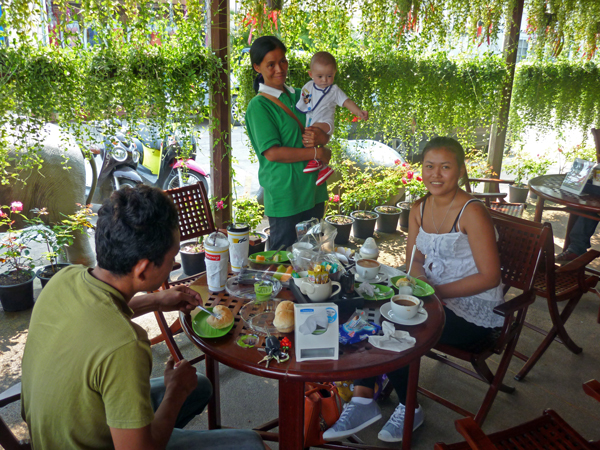 |
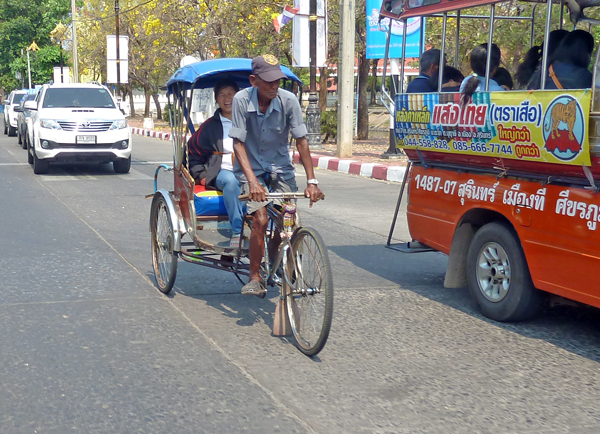
| 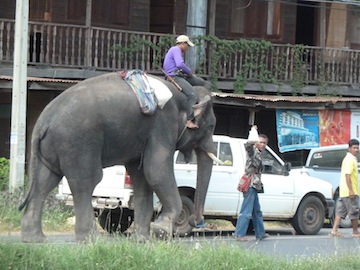 |
TOP: Coffee-shop in Surin city after taking baby Jack to see a paediatrician.
BOTTOM LEFT: A Surin trike-taxi.
BOTTOM RIGHT: Another type of Surin taxi. Not that many of this type about.
Nhong Rak village, Phanom Dhong Rak district.:
This where Aom’s house and farm is located. Dispel any images you may have of a village as such with groups of cottages/house close together. PDR is a widespread number of homesteads.
There’s no real centre to the “village”. There’s shop and a couple of eating shacks that sell noodles and the like and that’s about it for anything communal. For things like a post office, bank, bar/pub or supermarket you have to get 45 miles to Prasat, the nearest town. However, everyone knows everyone else and everything you do is transmitted magically within seconds.
Most of the houses are traditional Thai; wooden on stilts with outside thatched gazebo-type structures where the families meet, eat and sometimes cook on clay barbecue-like stoves. Charcoal is produced in a big clay furnace on the farm.
Aom’s farm: There are no animals kept apart from the dogs and shed loads of chickens ducks and other feathered things who pinch your food as soon as you turn your back for a second.
The occasional pig appears but that’s normally bumped off within weeks and eaten.
The farm is still largely agriculture.
The main crops are sugar-cane, cassava*, maize, mango, rice (of course), papaya, coconut, banana and rubber-tree.
The family buffalo was dispensed with a few years ago and replaced with single-cylinder diesel-powered lethal contraptions that chug around.
Cooking is done outdoors on a big gas hob and on small, round clay “barbecue” stoves.
However, now that the new house being built now has a full roof on it, cooking has largely been transferred indoors.
Sleeping is under mosquito-nets with wide-open windows. There is no air-conditioning; electric fans only when it gets too hot (which almost all year. round)
Life on the farm is fairly primitive, to be honest, and takes some getting used to; few luxuries here.
Lie-ins are almost an impossibility as dawn is heralded by a cacophony of quacks from over 40 ducks ... and then there are the cockerels!

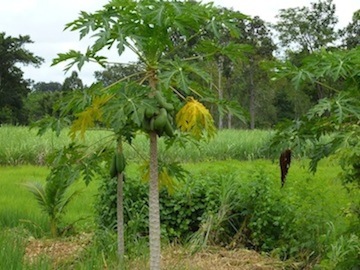
| 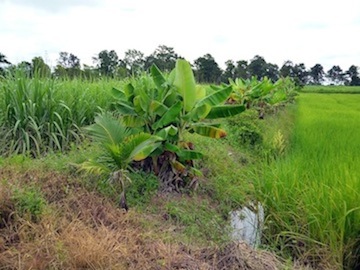 |
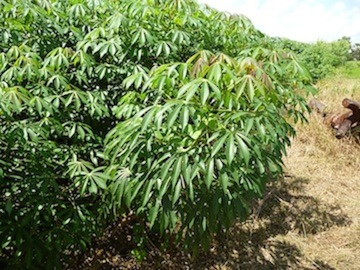
| 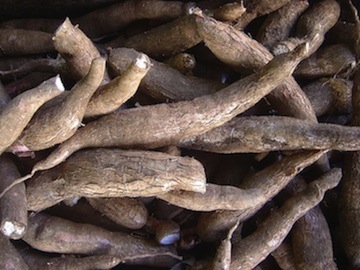 |
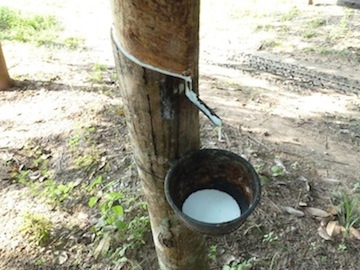
| 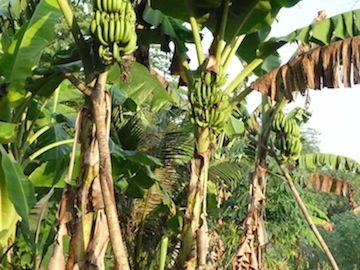 |
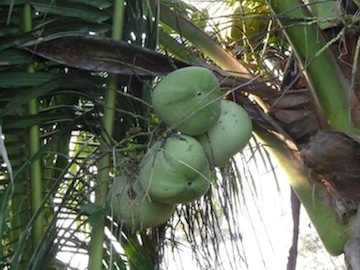
| 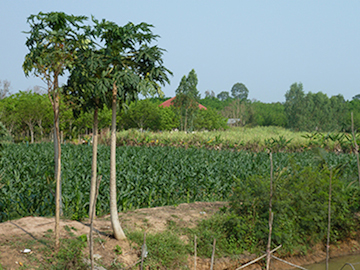 |
TOP LEFT: Papaya tree
TOP RIGHT: Sugarcane plantation on the left; young banana trees in the centre and rice 'paddy' on the right.
SECOND ROW LEFT: Cassava plantation. SECOND ROW RIGHT: Cassava edible roots.
THIRD ROW LEFT: Rubber tree; sap collector. THIRD ROW RIGHT: Banana trees with unripe fruit.
BOTTOM ROW LEFT: Unripe Coconuts.
- BOTTOM ROW RIGHT: Papaya tree in the left foreground and Maize in the fields beyond.
*Cassava:
Cassava also called manioc, balinghoy, mogo, mandioca, kamoteng kahoy, tapioca and manioc root is a perennial woody shrub with an edible root, which grows in tropical and subtropical areas such as here in Thailand.
It is rich in carbohydrates, calcium, vitamins B and C, and essential minerals. However, nutrient composition differs according to variety and age of the harvested crop, and soil conditions, climate, and other environmental factors during cultivation.
Apart from food, cassava is very versatile and its derivatives and starch are applicable in many types of products such as foods, confectionery, sweeteners, glues, plywood, textiles, paper, biodegradable products, monosodium glutamate, and drugs. Cassava chips and pellets are used in animal feed and alcohol production.





















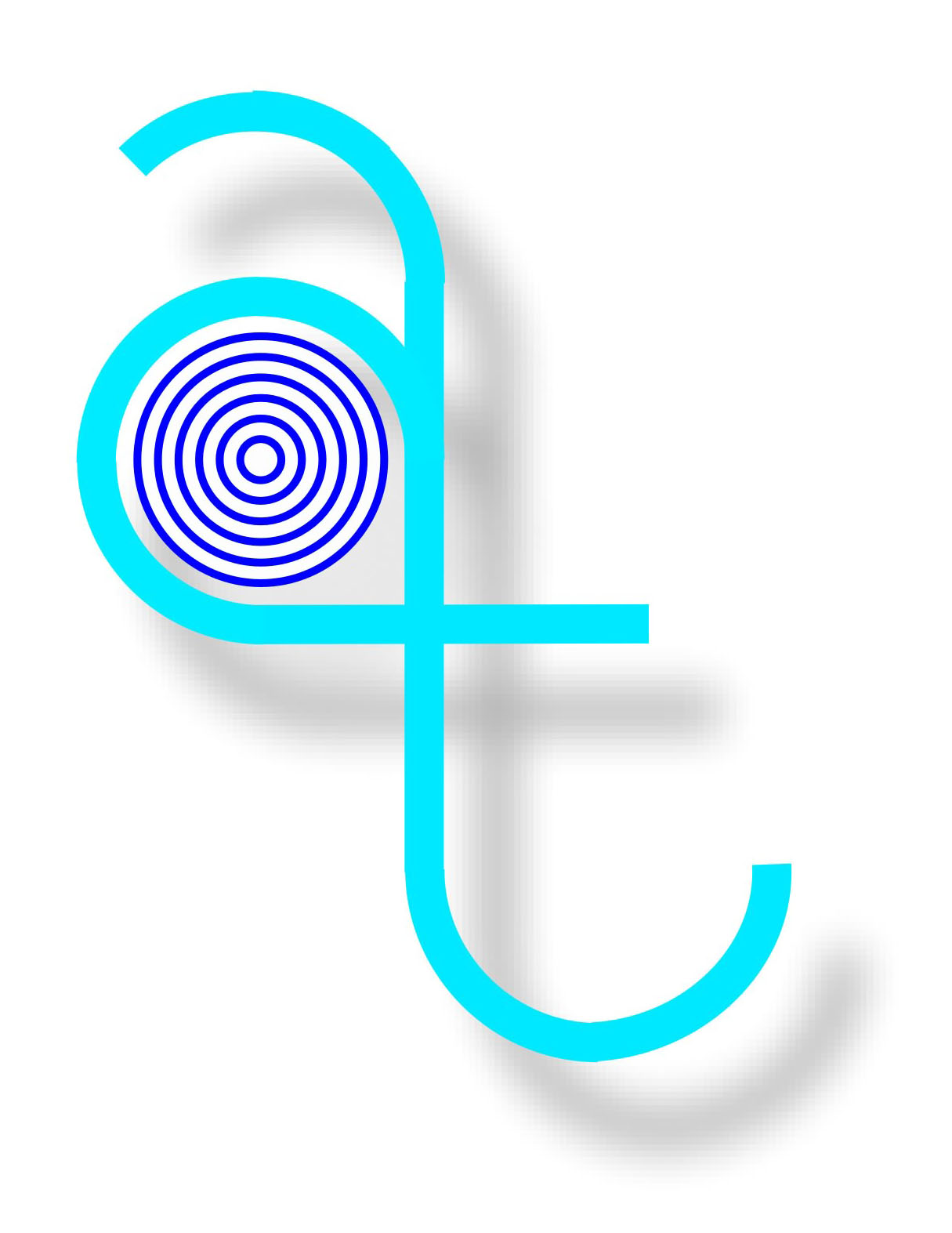 <
<
